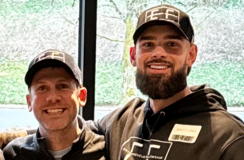his episode is a master class on working with banks to secure Small Business Administration (SBA) loans, and how to find the right lender for you.
Lisa Forrest is the Director of the SBA Financing and M&A division at Live Oak Bank, a national lender focused on fueling small business growth across the United States. Her 35 years of experience in the lending space have made Lisa an SBA loan guru, and she specializes in self-funded searchers.
In Lisa’s opinion, the best thing a buyer can do is build a strong relationship with their lender.
“I find within the first 15 minutes, searchers can probably identify who their top three lenders are going to be.”
Buyers must understand, however, that not all lenders will be right for their deal.
For example, SaaS and eCommerce businesses may not have the traditional cash flow metrics that many conventional banks look for. Having a thorough understanding of your value through the lens of the lender is critical when seeking a loan.
Additionally, Lisa helps searchers understand which outside factors to pay attention to when considering potential deals. Especially in the midst of the COVID-19 pandemic, buyers must understand the impacts that supply chain disruptions and labor shortages can have on their target businesses, and work with their lenders to make contingency plans.
In this episode of Acquiring Minds, Lisa shares insights on understanding debt-service coverage ratios (DSCR) and how business owners can partner strategically with their lenders during cash crunches. Lisa demystifies the SBA loan process, gives her top tips for getting the loan, and explains why now is a great time to buy a small business.
Check out:
✳️ Top takeaways from the episode
✳️ Episode highlights with timestamps
SBA Loan Expert: Lisa Forrest
💵 Becoming an SBA Expert: Lisa Forrest heads up the SBA financing and M&A Division at Live Oak Bank, a national lender focused on fueling small business growth across the United States. With over 35 years of experience in the lending space, Lisa specializes in self-funded searches and is an expert on all things SBA loans.
💡 Key quote: “There are a lot of factors fueling this idea of business acquisition, business selling, business buying, and it's a great time to be a buyer. Just make sure that you fully vetted the deals.”
👋 Where to find her: LinkedIn
Acquisition Tips From the Episode
Top takeaways from this conversation
💸 Debt-Service Coverage Ratio (DSCR): What it is and how it impacts your SBA loan.
At its most basic level, the debt-service coverage ratio (DSCR) scores a business’s ability to meet its loan payments using the business’s cash flow. More specifically, it’s the free cash flow divided by monthly loan payment. A ratio above 1 indicates that your business would still have positive cash flow after making its monthly loan payment. Live Oak, the bank where Lisa works, requires acquisition targets have a relatively high DSCR of 1.5.
As a simple example, imagine your loan payment is $10,000 per month. If a lender requires a DSCR of 1.5, the business you are looking at acquiring would need to have monthly cash flow of at least $15,000.
While other lenders require lower DSCR rates of 1.1 or 1.2, Lisa argues that a higher rate can actually benefit the buyer because it forces a cash flow cushion for leaner times.
Keep in mind that the DSCR is an approval standard, not a covenant. It requires business buyers to prove the business is making enough money to cover the debt at the time of the loan, but they do not necessarily have to maintain that DSCR threshold within the business every month thereafter.
🤝 Building a strong relationship with your lender partner pays dividends in the long run.
While the occasional quick business acquisition does happen, most of the time small business buyers can spend upwards of a year searching for a business. During this time, they’re working with their lenders to evaluate possible deals, so it’s beneficial to build strong relationships.
One way to initially build trust is to come prepared for your first conversation. Having your financial data and cash flow modeling on hand goes a long way, but banks also want more qualitative information. For example, what's your experience, what are your skills, and why are you interested in buying this company right now?
Taking the time to lay the groundwork with your lender can help you better navigate unknown waters, like SBA loan fees and contingency planning for when the going gets tough.
🆘 How lenders can help business owners during cash crunches.
Your relationship with your lender lasts far beyond the loan approval. In fact, lenders can be strategic partners in helping you handle major cash crunches.
Lisa shares how the supply chain disruption and labor shortages caused by the pandemic have thrown many business owners for a loop.
Her first piece of advice: Call your lender as soon as you feel the business sliding.
Early communication is key to finding creative solutions to cash flow woes. One way lenders can help is to extend your line of credit, giving you more breathing room if cash gets tight.
Another tactic Lisa recommends is writing a seller subordination clause into the loan, which states that any debt owed to the seller is secondary to the debt owed to the bank. Clauses like these allow business owners to defer loan payments to the seller during a crunch while they focus on building cash flow back up.
Episode Highlights
Inflection points from the show
[3:07] SBA loans versus common mortgage loans: SBA loans share some similarities with mortgage loans. For example, you must provide tax returns, bank statements, and personal financial information. But 75% of the SBA loan is about the business you’re acquiring versus you the borrower. You must be able to provide historical cash flow and financial information on your prospective business in order to secure the loan.
[4:20] Defining debt-service coverage ratio (DSCR): DSCR is a key factor lenders consider when evaluating acquisitions. It measures the business’s ability to cover its debt every month based on cash flow. Lenders can require ratios anywhere from 1.1 to 1.5.
[5:16] Business acquisition is a numbers game: Lisa tells first-time searchers that finding their acquisition is no easy task. Aspiring acquirers must be prepared to vet many deals, and they typically work with their lenders for at least a year.
[8:12] Lenders will look at more than your finances: In their evaluation process, lenders want to dig into qualitative analysis as well as quantitative. Lisa and her partner, Heather Anderson, use a questionnaire to help searchers understand if non-financial aspects of the business — like licensing requirements and day-to-day operations — pose potential risks.
[9:51] How to find the right lender for you: Would you prefer a high-touch lender that can act as an adviser, or a relatively hands-off partner?
[12:07] Why a lender that requires a high DSCR ratio might be a better fit: Though it sets a higher bar for securing the loan, requiring higher DSCR ratios means business owners have more cushion during times of lower cash flow. Lisa says this came in handy during 2020.
[14:34] Breaking down the SBA loan fees: Along with the 10% to 20% down payment, buyers should be prepared for additional fees, like the SBA guarantee fee and out-of-pocket costs for the lenders. The SBA usually charges around 2.5% to 2.75% on the loan, and lenders will charge a flat fee (usually around $10,000) for a business valuation, documentation, and attorney costs.
[17:20] Finding the right deal takes time: Lisa advises searchers not to fall in love with a deal too fast. Often, searchers need to vet upwards of 25 deals before finding “the one.”
[18:08] Don’t skimp on working capital: It’s understandable that entrepreneurs want to keep costs down, but Lisa stresses the importance of factoring an adequate amount of working capital into the loan structure.
[18:54] Pay attention to labor and supply chain: The pandemic has sent labor markets and supply chains into a spiral, racking up costs for many of Lisa’s clients. Have a contingency plan in place to ensure you can cover these types of disruptions.
[19:56] All aboard the SBA Express: In addition to the SBA loan, most lenders will extend lines of credit ranging from $100,000 to $250,000 to help small business acquirers secure working capital. Lisa notes that buyers are required to pay an additional SBA guarantee on top of their line of credit.
[24:08] What to prepare for your first conversation with a lender: Come prepared with cash flow modeling and an executive summary of your target business. Expect to be asked about seller notes, working capital, transition plans, employees, and customer concentration.
[28:10] Conventional SBA loans may not be the best fit for SaaS: Because SaaS business valuations are often based on annual recurring revenue (ARR), it can be difficult for acquisition entrepreneurs wanting to buy a SaaS to secure SBA loans if they cannot show historical cash flow that meets the DSCR. However, there are SBA lenders that specialize in SaaS.
[31:10] Not all lenders are created equal: Do your homework to evaluate which lender is right for you. While some lenders specialize in digital businesses, many — Lisa included — prioritize businesses with sustainable, repeatable cash flow when approving loans.
[35:17] It’s crunch time: Amidst supply chain disruption, labor shortages, and the great resignation, acquisition entrepreneurs and business owners need to pivot and find creative solutions to support their businesses.
[38:33] Self-funded search is exploding: Self-funded searching has really taken off in the past five years, with more and more small business acquirers entering the fray.
[39:44] It’s a great time to buy: Lisa cites the “silver tsunami” — the wave of retiring business owners — as one key driver pushing sellers to the table. Hardships from the global pandemic have also pressured many to sell. And the increasing amount of debt and equity floating around, as well as more accessible information around self-funded search, means it’s a buyers’ market.
[44:18] Office hours with SBA loan experts: Learn from SBA gurus Lisa and Heather by joining their weekly office hours on Wednesdays and Thursdays. Contact Lisa at lisa [dot] forrester [at] live oak [dot] bank to register for these.
Links & Mentions
✅ Acquiring Minds episode with Steve Ressler
✅ From Searcher to CEO: Analyzing and Mitigating Acquisition Transition Risk




%20-%20thumbnail.png)



%20-%20thumbnail.png)

.png)




%20-%20thumbnail.png)















%20-%20thumbnail.png)












































































